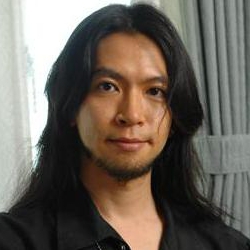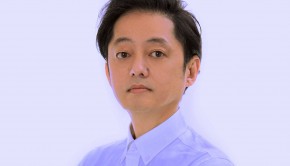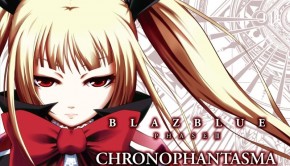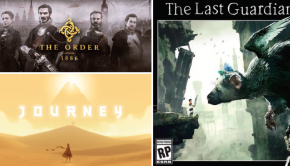Daisuke Ishiwatari Profile
 |
Also Known As: 石渡太輔 (いしわたりだいすけ) |
| Date of Birth: August 14, 1973 (Johannesburg) |
|
| Residence: Yokohama |
|
| Game Works: Guilty Gear, BlazBlue, Hard Corps: Uprising |
|
| Official Site: Arc System Works |
History
| Organisation | Type | Tenure | Role |
| Arc System Works | Game Developer | 1994 – 1996 | Designer |
| Arc System Works | Game Developer | 1996 – | Director, Producer, Planner, Designer, Sound Director, Composer |
Biography
Daisuke Ishiwatari is a legendary designer and composer famous for his work on the Guilty Gear and BlazBlue fighting series. Born on August 14, 1973 in Johannesburg to Japanese parents, Ishiwatari is nevertheless of Japanese heritage and spent much of his childhood in Japan. During his youth, he became obsessed with the band Queen and started to learn the electric guitar. He was later introduced to heavy metal and particularly enjoyed the melodic guitar-focused material of Iron Maiden and Guns N’ Roses. This inspired him to participate in several bands with friends and develop the ’metalhead’ image that has stayed with him since. He was also an avid of gaming at arcades, especially the versus fighting genre he would dedicate his life to. He decided to become a graphics designer, having demonstrated considerable artistic imagination as a youngster, and eventually chose video games as the medium to do this. In 1994, Ishiwatari joined Arc System Works as a designer. At the time he was recruited, the company were a small, little-known developer that mainly produced console ports of arcade titles. Marking his debut as an assistant designer on Virtual Open Tennis, he went on to serve as the lead designer for Exector, an ambitious but flawed third-person shooter with a sci-fi setting.
Over the subsequent two years, Ishiwatari achieved much more success as the planner and producer of the company’s first foray into the fighting sector, 1998’s Guilty Gear. While Ishiwatari had enjoyed fighting games as far back as 1991’s Street Fighter II and Fatal Fury, he felt the genre had become complacent. In response, he wanted to re-ignite the 2D fighting genre with a new game featuring a stylish anime-inspired presentation and over-the-top weapons-based gameplay. The development team for the title was exceptionally small for a PlayStation fighting title and Ishiwatari ended up handling most responsibilities himself — listed ten times on the game credits — while carefully communicating his vision to the other members of Team Neo Blood. He designed an incredible cast for the title — led by Sol Badguy, who he personally voiced — and also contributed to the gothic-inspired stage designs. To match the game’s visual component, Ishiwatari also penned the game’s hard rock soundtrack in collaboration with arranger Yasuharu Takanashi. He filled the soundtrack with guitar-focused character themes that were both hard-edged, yet charming and memorable. Its gloriously received soundtrack release was enhanced by instrumental performances and the newly composed “Prologue”.
Guilty Gear’s success inspired a line of follow-up titles for arcades, consoles, and handhelds. As director, planner, character designer, and composer for 2000’s multi-version Guilty Gear X, Ishiwatari oversaw the inclusion of new characters, a story mode, and revolutionary gameplay features. In addition to original tracks, the soundtrack offered fleshed out renditions of iconic melodies from the original game such as Sol’s “Keep Yourself Alive”, Ky’s “Holy Orders (Be Just Or Be Dead)”, and Millia’s “Writhe In Pain”. However, the power of the original version of the game’s music was limited by the Arcade software used, so Ishiwatari employed arranger Koichi Seiyama and guitarist Toru Iwao to remake the soundtrack for the Dreamcast and PlayStation versions, released on the Guilty Gear X Heavy Rock Tracks. The game’s popularity also resulted in Ishiwatari commissioning the production of a range of merchandise: three vocal CDs based on the game’s music featuring Japanese band Lapis Lazuli; two drama CDs with narration and voice acting by the game’s voice actors; and several artbooks containing production artwork and previously unseen designs by Daisuke Ishiwatari. Though the game didn’t sell as well as competitors such as SoulCalibur or Street Fighter, it inspired a large, dedicated fanbase nevertheless.
Ishiwatari had a large role in the greatest commercial success of the series, 2002’s Guilty Gear XX. The title was a technically accomplished upgrade of Guilty Gear X featuring new characters, new moves, and a few different gameplay mechanics. Koichi Seiyama returned as the arranger for its soundtrack while aiding Ishiwatari with composition duties. The artist considers the title to be the series’ definitive versus fighter fighter. As a result, he hasn’t produced any further true sequels and has instead focused on offering incremental improvements with new titles such as Guilty Gear XX Reload and Guilty Gear XX Accent Core Plus. Ishiwatari penned occasional new tracks for the titles, while handing over production of the Korean Reload soundtrack to band N.EX.T. Following the release of the main game, two heavy metal vocal albums, five drama discs, a live concert production, and an eight disc box set were published, all adapting Ishiwatari’s music. Attempting to diversify the Guilty Gear series beyond its roots, Ishiwatari focused 2004’s multi-platform Guilty Gear Isuka on four player tournament play. Despite the inevitable loss of character themes, its 20 track soundtrack was created in a similar style to its predecessors and was filled with head-banging performances.
As planner and director of 2007’s Guilty Gear 2: Overture, Ishiwatari aimed to produce a very different game that would inspire and surprise audiences just like the original Guilty Gear did. He shifted the gameplay from versus fighting to real-time strategy, took a more realistic approach to the graphics, and focused on new characters rather than returning ones. While some appreciated the creativity, the game generally alienated hardcore fans of the series. Its Xbox 360 exclusivity further contributed to low sales in Japan. Releasing the soundtrack across two volumes, one featured moody orchestral tracks that accompanied the cinematics, whereas the other channeled the hard rock sound fans of the series had come to know and love. While arrangers were principally responsible for the soundtrack, Ishiwatari was nevertheless credited with all the composition. Despite this failure, Ishiwatari continued to be held in high-esteem as a designer. Around the same time, Ishiwatari was asked to design the character Ma Dai for Sangokushi Taisen DS, produce some card illustrations for Dimension Zero, and served as the voice actor of Freed Velez in Battle Fantasia.
In 2008, Arc System Works released BlazBlue: Calamity Trigger as the spiritual successor to the Guilty Gear series. While the franchise was partly conceived in response to the commercial failure of Guilty Gear 2: Overture, Ishiwatari states that the company also wanted to appeal to mainstream audience, after the Guilty Gear series had grown quite exclusive. Though Toshimichi Mori handled the game’s production and design this time round, Ishiwatari returned as the sound director. For the arcade version, Ishiwatari wrote another hard rock score arranged by Yoshihiro Kusano and performed by a rock band; he carefully studied the artwork and background of each character to develop distinctive approaches, writing iconic tracks such as Ragna’s “Rebellion”, Jin’s “Lust SIN”, and Noel’s “Bullet Dance”. Ishiwatari supplemented the console version with 17 new tracks, primarily used during the story mode, as well as several vocal arrangements. He further developed the sound of the series on BlazBlue: Continuum Shift, its sequel, and its portable version. The artist paid particular attention to writing vocal compositions and covers for these titles, realising that fans would love them.
Despite taking a smaller role on the BlazBlue series, Ishiwatari took a more prominent role for the downloadable title Hard Corps: Uprising in 2011. As art director and lead character designer, he helped to conceive the stylish anime-influenced visuals for the title; though most of the animation work was conducted by an external studio, Ishiwatari coordinated with them throughout. As composer, he complemented the action-packed gameplay and his own illustrations with memorable rock tracks, including some tributes to Contra classics. With fighting games continuing to have a timeleess appeal, the designer also continues to support Arc System Works’ biggest fighters. The perfectionistic designer recently supported the release of the updated Guilty Gear XX Accent Core Plus R for Arcades and Vita. He also wrote the score for BlazBlue: Chrono Phantasma, combining remixes of familiar themes with portrayals of the new characters. To the delight of his fanbase, he appeared a special crossover concert featuring rock and vocal performances from the two series in 2011. In a minor work, he also recently designed the artwork of Powerglove’s Videogame Metal doujin album.
References:
– Various Game & Album Credits
– VGMdb Discography
– Company Site (Japanese)
– Interview with Gamasutra (English, January 2012)
© Biography by Chris Greening (September 2009). Last updated on April 7, 2013. Do not republish without formal permission.
Posted on April 7, 2013 by Chris Greening. Last modified on March 21, 2014.














